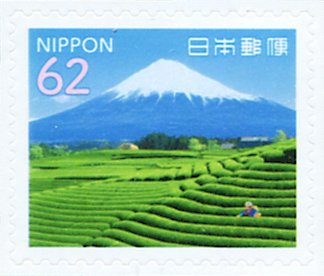Stamp: Tea Fields, Mt Fuji (Japan 2018)
Tea Fields, Mt Fuji (Japan 2018)
02 March (Japan ) within release My Journey Stamp Series 3 goes into circulation Stamp Tea Fields, Mt Fuji face value 62 Japanese yen
| Stamp Tea Fields, Mt Fuji in catalogues | |
|---|---|
| Michel: | Mi: JP 8991 |
| Sakura: | Sak: JP C2353d |
Stamp is horizontal format.
Also in the issue My Journey Stamp Series 3:
- Stamp - Waterfall face value 62;
- Stamp - Swan Ship on Lake, Mt Fuji face value 82;
- Stamp - Torii and Mt Fuji face value 62;
- Stamp - Nagoya Castle face value 62;
- Stamp - Hot Spring and Mt Fuji face value 82;
- Stamp - Peach Blossoms face value 82;
- Stamp - Moss Phlox (Phlox subulata), Mt Fuji face value 82;
- Stamp - Grapes face value 82;
- Stamp - Sun over Mt Fuji face value 82;
- Stamp - Bullet Train, Mt Fuji face value 62;
- Stamp - Tea Fields, Mt Fuji face value 62;
- Stamp - Cherry Trees and Mt Fuji face value 82;
- Stamp - Pine Tree and Mr Fuji face value 62;
- Stamp - Cherry Tree, Mt Fuji face value 62;
- Stamp - Wine and Glasses, Mt Fuji face value 82;
- Stamp - Cattle on Plateau, Mt Fuji face value 62;
- Stamp - Shinto Shrine face value 62;
- Stamp - Tea and a Sweet face value 62;
- Stamp - Peach Trees and Mt Fuji face value 82;
- Stamp - Pond and Mt Fuji face value 82;
- Stamp - Hot Spring and Mt Fuji face value 82;
- Stamp - Mt Fuji with Flowers face value 62;
- Stamp - Moss Phlox (Phlox subulata), Mt Fuji face value 82;
- Stamp - Waterfall face value 62;
- Stamp - Mt Fuji with Trees face value 62;
- Stamp - Peach Blossoms face value 82;
- Stamp - Nagoya Castle face value 62;
- Stamp - Mt Fuji with Clouds face value 82;
- Stamp - Mt Fuji with Clouds face value 120;
- Stamp - Swan Ship on Lake, Mt Fuji face value 82;
- Stamp - Torii and Mt Fuji face value 62;
- Stamp - Mt Fuji with Clouds face value 82;
Stamp Tea Fields, Mt Fuji it reflects the thematic directions:
Agriculture is the cultivation and breeding of animals, plants and fungi for food, fiber, biofuel, medicinal plants and other products used to sustain and enhance human life.[1] Agriculture was the key development in the rise of sedentary human civilization, whereby farming of domesticated species created food surpluses that nurtured the development of civilization. The study of agriculture is known as agricultural science. The history of agriculture dates back thousands of years, and its development has been driven and defined by greatly different climates, cultures, and technologies. Industrial agriculture based on large-scale monoculture farming has become the dominant agricultural methodology.
A landscape is the visible features of an area of land, its landforms and how they integrate with natural or man-made features. A landscape includes the physical elements of geophysically defined landforms such as (ice-capped) mountains, hills, water bodies such as rivers, lakes, ponds and the sea, living elements of land cover including indigenous vegetation, human elements including different forms of land use, buildings and structures, and transitory elements such as lighting and weather conditions. Combining both their physical origins and the cultural overlay of human presence, often created over millennia, landscapes reflect a living synthesis of people and place that is vital to local and national identity. The character of a landscape helps define the self-image of the people who inhabit it and a sense of place that differentiates one region from other regions. It is the dynamic backdrop to people’s lives. Landscape can be as varied as farmland, a landscape park, or wilderness. The earth has a vast range of landscapes, including the icy landscapes of polar regions, mountainous landscapes, vast arid desert landscapes, islands and coastal landscapes, densely forested or wooded landscapes including past boreal forests and tropical rainforests, and agricultural landscapes of temperate and tropical regions.
Tea is an aromatic beverage prepared by pouring hot or boiling water over cured or fresh leaves of Camellia sinensis, an evergreen shrub native to East Asia which probably originated in the borderlands of southwestern China and northern Myanmar. Tea is also made, but rarely, from the leaves of Camellia taliensis. After plain water, tea is the most widely consumed drink in the world. There are many different types of tea; some have a cooling, slightly bitter, and astringent flavour, while others have profiles that include sweet, nutty, floral, or grassy notes. Tea has a stimulating effect in humans, primarily due to its caffeine content
Tourism is travel for pleasure or business; also the theory and practice of touring, the business of attracting, accommodating, and entertaining tourists, and the business of operating tours. Tourism may be international, or within the traveller's country. The World Tourism Organization defines tourism more generally, in terms which go "beyond the common perception of tourism as being limited to holiday activity only", as people "traveling to and staying in places outside their usual environment for not more than one consecutive year for leisure, business and other purposes". Tourism can be domestic or international, and international tourism has both incoming and outgoing implications on a country's balance of payments. Today, tourism is a major source of income for many countries, and affects the economy of both the source and host countries, in some cases being of vital importance.
The United Nations Educational, Scientific and Cultural Organization (UNESCO; pronounced /juːˈnɛskoʊ/) is a specialized agency of the United Nations (UN) with the aim of promoting world peace and security through international cooperation in education, arts, sciences and culture. It has 194 member states and 12 associate members,as well as partners in the non-governmental, intergovernmental and private sector. Headquartered in Paris, France, UNESCO has 53 regional field offices and 199 national commissions





